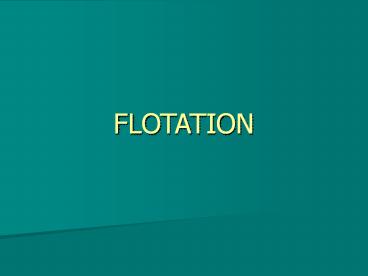FLOTATION - PowerPoint PPT Presentation
Title:
FLOTATION
Description:
FLOTATION INTRODUCTION Flotation is an operation that removes not only oil and grease but also suspended solids from wastewaters. The waste flow or a portion of ... – PowerPoint PPT presentation
Number of Views:3242
Avg rating:3.0/5.0
Title: FLOTATION
1
FLOTATION
2
INTRODUCTION
- Flotation is an operation that removes not only
oil and grease but also suspended solids from
wastewaters. - The waste flow or a portion of clarified effluent
is pressurized in the presence of sufficient air
to approach saturation.
3
Waste flow is pressurized to approach saturation
released to the atmospheric pressure
Minute air bubbles are released from the solution
SS, oil grease, sludge flocs are floated
attachment with air bubbles
Enmeshed in the floc particles
Air-solids mixture rises to the surface
4
AIR SOLUBILITY AND RELEASE
- The saturation of air in water is directly
proportional to pressure and inversely
proportional to temperature. - The quantity of air that will theoretically be
released from solution when the pressure is
reduced to 1 atm
5
AIR SOLUBILITY AND RELEASE
6
AIR SOLUBILITY AND RELEASE
- The actual quantity of air released will depend
- (i) upon the turbulent mixing conditions at the
point pressure reduction - (ii) on the degree of saturation obtained in
- the pressurizing system
7
AIR SOLUBILITY AND RELEASE
- Since the solubility in industrial wastes may be
less than that in water, a correction have to be
applied
8
FLOTATION UNIT
- The performance of a flotation system depends
upon having sufficient air bubbles present to
float substantially all of the suspended solids . - An insufficient quantity of air will result in
only partial flotation of the solids, and
excesive air will yield no improvement.
9
FLOTATION UNIT
- The performance of a flotation unit terms of
effluent quality and solids concentration in the
float can be related to an air/solids ratio
10
(No Transcript)
11
FLOTATION UNIT
12
FLOTATION UNIT
- When pressurized recycle is used
13
DAF
- The most common procedure is that of dissolved
air flotation (DAF), in which the waste stream is
first pressurized with air in a closed tank. - After passing through a pressure-reduction valve,
the wastewater enters the flotation tank where,
due to the sudden reduction in pressure, minute
air bubbles in the order of 50- 100 microns in
diameter are formed.
14
DAF
- As the bubbles rise to the surface, the suspended
solids and oil or grease particles adhere to them
and are carried upwards. - It is common practice to use chemicals to enhance
flotation performance. - One alternate design involves the recycling of
part (10-30) of the treated water.
15
DAF
- All systems contain a mechanism for removing the
solids that may settle to the bottom of the
flotation tanks, usually by a helical conveyor
placed in the conical bottom. - The main advantage claimed of DAF systems is the
faster rate at which very small or light
suspended solids can be removed in comparison
with settling.
16
DAF
- Performance of DAF systems has been reported to
be dependent on several factors - the solids concentration
- the ratio of air to solids (A/S)
- Key factors in the successful operation of DAF
units are - the maintenance of proper pH
- proper flow rates
- the continuous presence of trained operators
17
DAF
18
DAF
- Diagram of a DAF system with recycle
19
DAF
20
DAF
21
DAF
22
SURFACE AERATOR
- Another flotation system exists in which air is
not dissolved but forced through the wastewater
by surface aerators. - This system generates air bubbles of larger size
than DAF systems.

